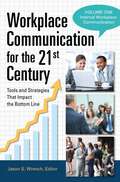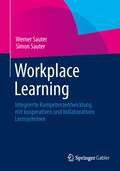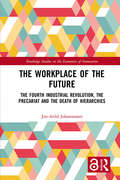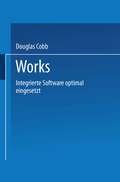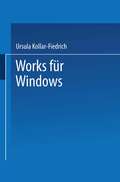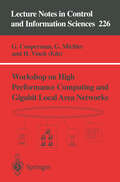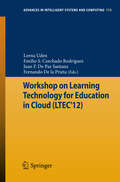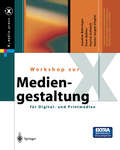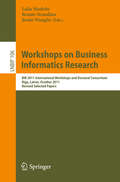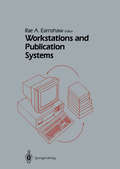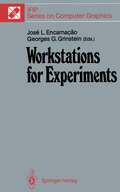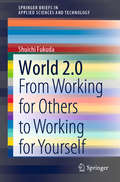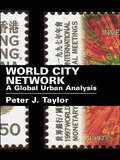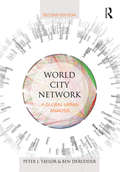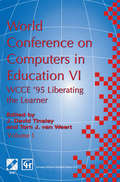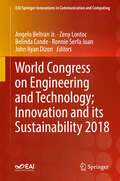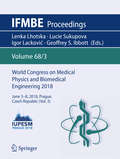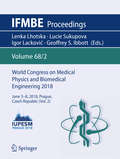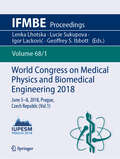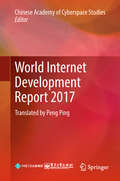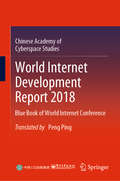- Table View
- List View
Workplace Communication for the 21st Century [2 volumes]: Tools and Strategies That Impact the Bottom Line [2 volumes]
by Jason S. WrenchWritten in clear, non-technical language, this book explains how employees and employers can maximize internal and external organizational communication—for both personal benefit and to the entity as a whole.Workplace Communication for the 21st Century: Tools and Strategies That Impact the Bottom Line explains and simplifies what organizational communication scholars have learned, presenting this knowledge so that it can be easily applied to generate tangible benefits to employees and employers as they face everyday challenges in the real world.This two-volume work discusses internal organizational and external organizational communication separately, first explaining how communication functions within the confines of a modern organization, then addressing how organizations interact with various stakeholders, such as customers, clients, and regulatory agencies. The expert contributors provide a thorough and insightful view on organizational communication and supply a range of strategies that will be useful to practitioners and academics alike.
Workplace Learning: Integrierte Kompetenzentwicklung mit kooperativen und kollaborativen Lernsystemen
by Werner Sauter Simon SauterSocial Business erfordert kollaborative Unternehmen, in denen Arbeiten und Lernen wieder zusammen wachsen. Auf der Grundlage einer Analyse der voraussichtlichen Entwicklung der Rahmenbedingungen der Arbeitswelt und der betrieblichen Lernsysteme in der Zukunft werden in diesem Werk die Anforderungen an innovative Kompetenzentwicklungssysteme mit E-Learning, Blended Learning , Social Learning und Workplace Learning abgeleitet. Es vermittelt praxiserprobte Lösungskonzepte und Entscheidungshilfen für die Entwicklung und Einführung zukunftsorientierter Lernsysteme mit dem Ziel, eine Kultur kollaborativen Arbeitens und Lernens am „Workplace“ zu initiieren.
The Workplace of the Future: The Fourth Industrial Revolution, the Precariat and the Death of Hierarchies (Routledge Studies in the Economics of Innovation)
by Jon-Arild JohannessenThe Fourth Industrial Revolution is a global development that shows no signs of slowing down. In his book, The Workplace of the Future: The Fourth Industrial Revolution, the Precariat and the Death of Hierarchies, Jon-Arild Johannessen sets a chilling vision of how robots and artificial intelligence will completely disrupt and transform working life. The author contests that once the dust has settled from the Fourth Industrial Revolution, workplaces and professions will be unrecognizable and we will see the rise of a new social class: the precariat. We will live side by side with the 'working poor' – people who have several jobs, but still can’t make ends meet. There will be a small salaried elite consisting of innovation and knowledge workers. Slightly further into the future, there will be a major transformation in professional environments. Johannessen also presents a typology for the precariat, the uncertain work that is created and develops a framework for the working poor, as well as for future innovation and knowledge workers, and sets out a new structure for the social hierarchy. A fascinating and thought-provoking insight into the impact of the Fourth Industrial Revolution, The Workplace of the Future will be of interest to professionals and academics alike. The book is particularly suited to academic courses in management, economy, political science and social sciences.
The Workplace of the Future: The Fourth Industrial Revolution, the Precariat and the Death of Hierarchies (Routledge Studies in the Economics of Innovation)
by Jon-Arild JohannessenThe Fourth Industrial Revolution is a global development that shows no signs of slowing down. In his book, The Workplace of the Future: The Fourth Industrial Revolution, the Precariat and the Death of Hierarchies, Jon-Arild Johannessen sets a chilling vision of how robots and artificial intelligence will completely disrupt and transform working life. The author contests that once the dust has settled from the Fourth Industrial Revolution, workplaces and professions will be unrecognizable and we will see the rise of a new social class: the precariat. We will live side by side with the 'working poor' – people who have several jobs, but still can’t make ends meet. There will be a small salaried elite consisting of innovation and knowledge workers. Slightly further into the future, there will be a major transformation in professional environments. Johannessen also presents a typology for the precariat, the uncertain work that is created and develops a framework for the working poor, as well as for future innovation and knowledge workers, and sets out a new structure for the social hierarchy. A fascinating and thought-provoking insight into the impact of the Fourth Industrial Revolution, The Workplace of the Future will be of interest to professionals and academics alike. The book is particularly suited to academic courses in management, economy, political science and social sciences.
Workplace Violence: Planning for Prevention and Response
by Kim KerrWorkplace violence in all its forms is becoming more prevalent and pervasive every year. Workplace Violence: Planning for Prevention and Response gives a comprehensive account of the problem using a multi-faceted approach to the issues surrounding workplace violence incidents, addressing how the topic affects victims, witnesses, the workforce, family members, and management. A series of chapters helps organizations to form action and response plans to manage incidents both large and small. The focus also includes organizations that are forced to address violent individuals in settings where law enforcement may not be immediately available. Kerr speaks first-hand about complex issues like corporate liability for violent or threatening acts committed by employees, as well as issues of privacy, and he includes chapters written by experts on legal issues, cyberthreats, and anger in the workplace. This book belongs on the desk of every security manager and HR professional, and offers solid advice to all managers regardless of the size of their organization.Details the problem from all angles to help the reader design a comprehensive strategy for all constituent groupsProvides proven, detailed support for creating policies and procedures, awareness, and response trainingDiscuses real-life case studies to help readers understand how to apply strategies discussed in the book
Works: Integrierte Software optimal eingesetzt
by Douglas Ford CobbVORWORT Microsoft Works ist eines der interessantesten Programme für DOS-kompatible Personal Computer. W orks ist ein integriertes Softwarepaket, das alle Programme in sich vereint, die man von einem integrierten Softwarepaket erwartet: Textverarbeitung, Tabellenkalkulation einschließlich Diagrammer stellung, Datenbankverwaltung und Datenkommunikation -und das zu einem Preis, den sich die meisten Anwender leisten können. Ein leistungsstarkes, aus gereiftes Produkt für die neue Generation von Computern und Anwendern. Works bietet Möglichkeiten, wie sie in dieser Preiskategorie wohl unüber troffen sein dürften, denn jedes Works-Dokument stellt ein völlig selbständiges Programm dar. Im Mittelpunkt steht die Textverarbeitung, die alle Werkzeuge enthält, die zur Erstellung professioneller Memos, Berichte und Briefe erforderlich sind. Außerdem bietet Works eine leistungsstarke Tabellenkalkulation, die beispiels weise mit Lotus 1-2-3 voll kompatibel ist. Zusätzlich besteht die Möglichkeit, aus den Daten der Tabellenkalkulation mit Hilfe der Diagrammeinrichtung schnell und mühelos Präsentations-Diagramme anzufertigen. Mit der formular orientierten Datenbankverwaltung können Informationen gespeichert, sortiert und abgefragt werden, die dann später vom Berichtgenerator zur Anfertigung von Reports verwendet werden. Und da bei Works diese verschiedenen Ein richtungen in einem Softwarepaket integriert sind, können die Informationen zwischen den einzelnen Dokumenten beliebig ausgetauscht werden. Zu diesem Buch Das vorliegende Buch will anhand von Mustertabellen zeigen, wie man Works Dokumente kreativ und sinnvoll einsetzen kann. Jedes Kapitel stellt ein Arbeitsb latt vor, einige davon sind ganz einfach, andere dagegen recht komplex. Einige Arbeitsblätter sind für den privaten Einsatz bestimmt und andere für Unternehmen. Alle Beispiele, bzw. Arbeitstabellen, sind als prak tische Hilfe für den Einsatz von Works gedacht.
Workshop on High Performance Computing and Gigabit Local Area Networks (Lecture Notes in Control and Information Sciences #226)
by G. Cooperman G. Michler H. VinckThe combination of fast, low-latency networks and high-performance, distributed tools for mathematical software has resulted in widespread, affordable scientific computing facilities. Practitioners working in the fields of computer communication networks, distributed computing, computational algebra and numerical analysis have been brought together to contribute to this volume and explore the emerging distributed and parallel technology in a scientific environment. This collection includes surveys and original research on both software infrastructure for parallel applications and hardware and architecture infrastructure. Among the topics covered are switch-based high-speed networks, ATM over local and wide area networks, network performance, application support, finite element methods, eigenvalue problems, invariant subspace decomposition, QR factorization and Todd-Coxseter coset enumeration.
Workshop on Learning Technology for Education in Cloud (Advances in Intelligent Systems and Computing #173)
by Emilio S. Corchado Rodríguez Juan F. De Paz Santana Fernando De La Prieta Lorna UdenLearning Technology for Education in Cloud investigates how cloud computing can be used to design applications to support real time on demand learning using technologies. The workshop proceedings provide opportunities for delegates to discuss the latest research in TEL (Technology Enhanced Learning) and its impacts for learners and institutions, using cloud. The Workshop on Learning Technology for Education in Cloud (LTEC '12) is a forum where researchers, educators and practitioners came together to discuss ideas, projects and lessons learned related to the use of learning technology in cloud, on the 11th-13th July at Salamanca in Spain.
Workshop zur Mediengestaltung für Digital- und Printmedien (X.media.press)
by J. Böhringer P. Bühler P. Schlaich H.-J. ZieglerWorkshops on Business Informatics Research: BIR 2011 International Workshops and Doctoral Consortium, Riga, Latvia, October 6, 2011 Revised Selected Papers (Lecture Notes in Business Information Processing #106)
by Laila Niedrite Renate Strazdina Benkt WanglerThis book constitutes the refereed and revised proceedings of the workshops and the doctoral consortium co-located with the 10th International Conference on Perspectives in Business Informatics Research (BIR), held in Riga, Latvia, in October 2011. The four workshops focused on Information Logistics and Knowledge Supply for Viable Enterprises (ILOG 2011), Alignment of Business Processes and Security Modeling (ABPSM 2011), Intelligent Educational Systems and Technology-Enhanced Learning (INTEL-EDU 2011), and User-Oriented Information Integration (UOII 2011). The two best papers from the doctoral consortium are also included.
Workstations and Publication Systems
by Rae A. EarnshawReview Office automation and associated hardware and software technologies are producing significant changes in traditional typing, printing, and publishing techniques and strategies. The long term impact of current developments is likely to be even more far reaching as reducing hardware costs, improved human-computer interfacing, uniformity through standardization, and sophisticated software facilities will all combine together to provide systems of power, capability and flexibility. The configuration of the system can be matched to the requirements of the user, whether typist, clerk, secretary, scientist, manager, director, or publisher. Enormous advances are currently being made in the areas of publication systems in the bringing together of text and pictures, and the aggregation of a greater variety of multi-media documents. Advances in technology and reductions in cost and size have produced many 'desk-top' publishing systems in the market place. More sophisticated systems are targeted at the high end of the market for newspaper production and quality color output. Outstanding issues in desk-top publishing systems include interactive editing of structured documents, integration of text and graphics, page description languages, standards, and the human-computer interface to documentation systems. The latter area is becoming increasingly important: usability by non-specialists and flexibility across application areas are two current concerns. One of the objectives of current work is to bring the production of high quality documents within the capability of naive users as well as experts.
Workstations for Experiments: IFIP WG 5.10 International Working Conference Lowell, MA, USA, July 1989 (IFIP Series on Computer Graphics)
by Jose L. Encarnacao Georges G. GrinsteinPowerful new technology has been made available to researchers by an increasingly competitive workstation market. Papers from Canada, Japan, Italy, Germany, and the U.S., to name a few of the countries represented in this volume, discuss how workstations are used in experiments and what impact this new technology will have on experiments. As usual for IFIP workshops, the emphasis in this volume is on the formulation of strategies for future research, the determination of new market areas, and the identification of new areas for workstation research. This is the first volume of a book series reporting the work of IFIP WG 5.10. The mission of this IFIP work- ing group is to promote, develop and encourage advancement of the field of computer graphics as a basic tool, as an enabling technology and as an important part of various application areas.
World 2.0: From Working for Others to Working for Yourself (SpringerBriefs in Applied Sciences and Technology)
by Shuichi FukudaThis book explores on how the Internet of Things (IoT) will change society by bringing living and non-living things together. The IoT is currently attracting considerable attention, but most of the discussions focus on engineering aspects alone. The IoT, however, is not an extension of traditional engineering, where humans and machines are separated. Instead it connects humans and machines, enabling them to work together as a team: the IoT Connected Society.In traditional engineering, our knowledge and experience of physical and non-living things plays a key role, but such knowledge and experience alone are not enough. We need to introduce life science approaches and integrate them into physical science to really develop the IoT connected society.In addition, the Internet is not only a tool for delivering messages: it is a broader communication tool. In the IoT connected society, living things and non-living things communicate in complex ways. Machines 1. Introduction2. Emerging Industrial Revolution3. IoT: What makes it different from the past revolutions4. World is changing5. Engineering: How It was developed so far6. Humans: Their characteristics7. Value is changing8. Adaptive team organization and management9. Integration of Physical Science and Life Science10. Summary can provide humans with a improved situational awareness and advice, and together they can communicate to develop a better, happier society. Thus, this book makes the case that to make the IoT connected society a reality, we need to integrate the physical and life sciences and develop a new science for the next generation of engineering.
World City Network: A Global Urban Analysis
by Peter J. Taylor Ben DerudderWith the advent of multinational corporations, the traditional urban service function has 'gone global'. In order to provide services to globalizing corporate clients, the offices of major financial and business service firms across the world have formed a network. It is the myriad of flows between office towers in different metropolitan centres that has produced a world city network. Through an analysis of the intra-company flows of 100 leading global service firms across 315 cities, this book assesses cities in terms of their overall network connectivity, their connectivity by service sector, and their connectivity by world region. Peter Taylor's unique and illuminating book provides the first comprehensive and systematic description and analysis of the world city network as the 'skeleton' upon which contemporary globalization has been built. His analyses challenge the traditional view of the world as a 'mosaic map' of political boundaries. Written by one of the foremost authorities on the subject, this book provides a much needed mapping of the connecting relationships between world cities, and will be an enlightening book for students of urban studies, geography, sociology and planning.
World City Network: A Global Urban Analysis
by Peter J. Taylor Ben DerudderWith the advent of multinational corporations, the traditional urban service function has 'gone global'. In order to provide services to globalizing corporate clients, the offices of major financial and business service firms across the world have formed a network. It is the myriad of flows between office towers in different metropolitan centres that has produced a world city network. Through an analysis of the intra-company flows of 100 leading global service firms across 315 cities, this book assesses cities in terms of their overall network connectivity, their connectivity by service sector, and their connectivity by world region. Peter Taylor's unique and illuminating book provides the first comprehensive and systematic description and analysis of the world city network as the 'skeleton' upon which contemporary globalization has been built. His analyses challenge the traditional view of the world as a 'mosaic map' of political boundaries. Written by one of the foremost authorities on the subject, this book provides a much needed mapping of the connecting relationships between world cities, and will be an enlightening book for students of urban studies, geography, sociology and planning.
World City Network: A global urban analysis
by Peter J. Taylor Ben DerudderWith the advent of multinational corporations, the traditional urban service function has 'gone global'. In order to provide services to globalizing corporate clients, the offices of major financial and business service firms across the world have generated networks of work. It is the myriad of flows between office towers in different metropolitan centres that has produced a world city network. Taylor and Derudder's unique and illuminating book provides both an update and a substantial revision of the first edition that was published in 2004. It provides a comprehensive and systematic description and analysis of the world city network as the 'skeleton' upon which contemporary globalization has been built. Through an analysis of the intra-company flows of 175 leading global service firms across 526 cities in 2012, this book assesses cities in terms of their overall network connectivity, the regional configurations they form, and their changing position in the period 2000-12. Results are used to reflect on cities and city/state relations in the context of the global ecological and economic crisis. Written by two of the foremost authorities on the subject, this book provides a much-needed mapping of the connecting relationships between world cities, and will be a valuable resource for students of urban studies, geography, sociology and planning.
World City Network: A global urban analysis
by Peter J. Taylor Ben DerudderWith the advent of multinational corporations, the traditional urban service function has 'gone global'. In order to provide services to globalizing corporate clients, the offices of major financial and business service firms across the world have generated networks of work. It is the myriad of flows between office towers in different metropolitan centres that has produced a world city network. Taylor and Derudder's unique and illuminating book provides both an update and a substantial revision of the first edition that was published in 2004. It provides a comprehensive and systematic description and analysis of the world city network as the 'skeleton' upon which contemporary globalization has been built. Through an analysis of the intra-company flows of 175 leading global service firms across 526 cities in 2012, this book assesses cities in terms of their overall network connectivity, the regional configurations they form, and their changing position in the period 2000-12. Results are used to reflect on cities and city/state relations in the context of the global ecological and economic crisis. Written by two of the foremost authorities on the subject, this book provides a much-needed mapping of the connecting relationships between world cities, and will be a valuable resource for students of urban studies, geography, sociology and planning.
World Conference on Computers in Education VI: WCCE ’95 Liberating the Learner, Proceedings of the sixth IFIP World Conference on Computers in Education, 1995 (IFIP Advances in Information and Communication Technology)
by David Tinsley Tom J. Van WeertIn this book about a hundred papers are presented. These were selected from over 450 papers submitted to WCCE95. The papers are of high quality and cover many aspects of computers in education. Within the overall theme of "Liberating the learner" the papers cover the following main conference themes: Accreditation, Artificial Intelligence, Costing, Developing Countries, Distance Learning, Equity Issues, Evaluation (Formative and Summative), Flexible Learning, Implications, Informatics as Study Topic, Information Technology, Infrastructure, Integration, Knowledge as a Resource, Learner Centred Learning, Methodologies, National Policies, Resources, Social Issues, Software, Teacher Education, Tutoring, Visions. Also included are papers from the chairpersons of the six IFIP Working Groups on education (elementary/primary education, secondary education, university education, vocational education and training, research on educational applications and distance learning). In these papers the work in the groups is explained and a basis is given for the work of Professional Groups during the world conference. In the Professional Groups experts share their experience and expertise with other expert practitioners and contribute to a postconference report which will determine future actions of IFIP with respect to education. J. David Tinsley J. van Weert Tom Editors Acknowledgement The editors wish to thank Deryn Watson of Kings College London for organizing the paper reviewing process. The editors also wish to thank the School of Informatics, Faculty of Mathematics and Informatics of the Catholic University of Nijmegen for its support in the production of this document.
World Congress on Engineering and Technology; Innovation and its Sustainability 2018 (EAI/Springer Innovations in Communication and Computing)
by Angelo Beltran Jr. Zeny Lontoc Belinda Conde Ronnie Serfa Juan John Ryan DizonThe book presents the proceedings of the World Congress on Engineering and Technology, Innovation and its Sustainability (WCETIS 2018), which took place on November 28-29, 2018 in Manila, Philippines. The conference featured the following tracks: Industrial Engineering and Healthcare, Sustainable Infrastructure; Water Resources Planning and Management; Heat transfer and fluids; Electronics and Electrical Engineering; and Internet of Things. Papers stem from academia and industry throughout the world, showing a variety of perspectives.Presents the proceedings of the World Congress on Engineering and Technology, Innovation and its Sustainability (WCETIS 2018), November 28-29, 2018 in Manila, PhilippinesShows how engineering and technology serve to support a variety for industries from manufacturing to water resourcesFeatures papers from a variety of researchers and developers from around the world
World Congress on Medical Physics and Biomedical Engineering 2018: June 3-8, 2018, Prague, Czech Republic (Vol.3) (IFMBE Proceedings #68/3)
by Lenka Lhotska Lucie Sukupova Igor Lacković Geoffrey S. IbbottThis book (vol. 3) presents the proceedings of the IUPESM World Congress on Biomedical Engineering and Medical Physics, a triennially organized joint meeting of medical physicists, biomedical engineers and adjoining health care professionals. Besides the purely scientific and technological topics, the 2018 Congress will also focus on other aspects of professional involvement in health care, such as education and training, accreditation and certification, health technology assessment and patient safety. The IUPESM meeting is an important forum for medical physicists and biomedical engineers in medicine and healthcare learn and share knowledge, and discuss the latest research outcomes and technological advancements as well as new ideas in both medical physics and biomedical engineering field.
World Congress on Medical Physics and Biomedical Engineering 2018: June 3-8, 2018, Prague, Czech Republic (Vol.2) (IFMBE Proceedings #68/2)
by Lenka Lhotska Lucie Sukupova Igor Lacković Geoffrey S. IbbottThis book (vol. 2) presents the proceedings of the IUPESM World Congress on Biomedical Engineering and Medical Physics, a triennially organized joint meeting of medical physicists, biomedical engineers and adjoining health care professionals. Besides the purely scientific and technological topics, the 2018 Congress will also focus on other aspects of professional involvement in health care, such as education and training, accreditation and certification, health technology assessment and patient safety. The IUPESM meeting is an important forum for medical physicists and biomedical engineers in medicine and healthcare learn and share knowledge, and discuss the latest research outcomes and technological advancements as well as new ideas in both medical physics and biomedical engineering field.
World Congress on Medical Physics and Biomedical Engineering 2018: June 3-8, 2018, Prague, Czech Republic (Vol.1) (IFMBE Proceedings #68/1)
by Lenka Lhotska Lucie Sukupova Igor Lacković Geoffrey S. IbbottThis book (vol. 1) presents the proceedings of the IUPESM World Congress on Biomedical Engineering and Medical Physics, a triennially organized joint meeting of medical physicists, biomedical engineers and adjoining health care professionals. Besides the purely scientific and technological topics, the 2018 Congress will also focus on other aspects of professional involvement in health care, such as education and training, accreditation and certification, health technology assessment and patient safety. The IUPESM meeting is an important forum for medical physicists and biomedical engineers in medicine and healthcare learn and share knowledge, and discuss the latest research outcomes and technological advancements as well as new ideas in both medical physics and biomedical engineering field.
World Internet Development Report 2017
by Chinese Academy of Cyberspace StudiesAn important outcome of the Fourth World Internet Conference, this book provides a comprehensive account of the status quo and trends in global Internet development. Covering network infrastructure, information technology, digital economy, e-governance, cyber security, and international cyberspace governance, it presents the Global Internet Development Index System to assess the Internet development of various major countries and emerging economies.
World Internet Development Report 2018: Blue Book of World Internet Conference
by Chinese Academy of Cyberspace StudiesThis book is an important outcome of the Fifth World Internet Conference. It provides a comprehensive account of the new trends and highlights of global Internet development over the past year, covering network infrastructure, information technology, digital economy, world internet media, cyber security, and international cyberspace governance. This year, the book improves the Global Internet Development Index System and adds more countries into the assessed list, in order to reflect more comprehensively, objectively and accurately the general situation of the world Internet development and thus to provide reference for all countries in promoting Internet development and governance.
